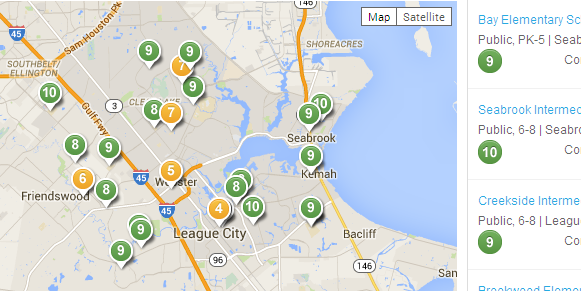So you’re moving to Houston and want to know about where the best district is for an autistic child. Or, you’re already living somewhere in the Greater Houston area and don’t like the services your child is receiving. Or perhaps you’ve heard from a parent or read on City-Data.com that Katy or Spring Branch are the best, and are wondering if it is true, and whether you are doing a disservice to your child by not uprooting your family, selling your house and moving to another side of town.

Parents of typical kids have GreatSchools.org rating scale and the TEA’s accountability rating system to use as a guide to great schools. Nothing like this exists for Special Ed programs. EA hopes to change that.
There are now plenty of websites to tell you where the best schools are for neuro-typical kids: GreatSchools.org, SchoolDigger.com, TheBestSchools.org, to name a few. Standardized test scores and a state-wide public accountability rating system make it easy to evaluate the effectiveness of schools for educating typical students. But for students with IEPs, effectiveness is harder to evaluate because the education is individualized for the student, and even services (OT, Speech, etc.) are also based, ideally, on individual need–not what your district makes available. Because of this, parent perception is all we have to go on when it comes to special ed. services.
As a parent, it is disconcerting that the Texas Education Agency offers no “accountability rating system” for Special Education. (The TEA designates what schools are Exemplary, Recognized, Academically Acceptable and Academically Unacceptable.)
Before moving from California to the Houston area in 2009, I asked the Special Education Department of the TEA ([email protected]) for assistance determining which school districts were better for Special Education, specifically for an autistic child. I asked again on 5/30/14, but I learned that there is no assessment that would allow schools or school districts to be rated or compared:
I am a parent who lives in the Clear Creek Independent School District service area (SE Houston), but I am not too far from other ISDs like Pasadena, Alvin and Friendswood. I have an autistic 9 year old boy.
I’ve noticed over the years parents seeking information about what one district provides vs. another in terms of services to autistic children.
Does the TEA, or any education agency in Texas, provide some kind of objective rating system for evaluating districts in terms of the number and quality of services they provide to special needs kids?
And is this information published anywhere?
Of course, standardized tests are used to decide which school districts are exemplary for normal kids, but that’s not necessarily a good metric for kids that need assistance/training for tying their shoes and using a spoon.
A prime example is the availability of summer and after school programs offered by or through the district.
As a working mom faced with the challenges of finding appropriate after school care and full day daycare for a child who cannot participate in camps and after school programs designed for typical kids (and who will “age out” of these programs at the age of 12), I have noticed that our neighboring district, Pasadena ISD, has partnered with their rec center to provide all sorts of summer and after school activities for special needs kids. They have a low staff/student ratio and staff are trained to work with these kids. Transportation is provided by the school.
Yet CCISD, which I believe is a much larger district, offers no summer school and no after school programs for developmentally disabled kids.
Extended school year and extended day programs are two programs that would be important to ANY parent of a disabled child, but I can list several others.
Another issue is transition planning. Are some districts — perhaps even due to their proximity to employers — experiencing greater success in terms of vocational training and job placement?
Basically, does the TEA provide any kind of mechanism to help parents to assess school districts objectively in terms of special needs programs and services?
If not, they really should.
Here is what I was told:
There is not a rating system by the agency. Schools are required to provide services and supports to students with disabilities based on the individual needs of the students as is defined in IDEA 2004, state law, and Commissioner’s Rules. There are over 1200 independent school districts in Texas. Each one is independent. Districts differ based on needs and resources in their areas. If you have additional questions please contact us at 512.463.9414.
In the US, special education services are governed by the Individuals with Disabilities Education Act (IDEA), but certainly there some school districts better equipped to accommodate special needs kids than others–though maybe no school administrator wants to admit this.
Schools are so fearful of being sued that it is often difficult to obtain good information from them. My first official, public use of the Everything Autism logo and email address ([email protected]) was a school district survey. I designed it to try to obtain information which I thought would be most helpful to other parents. But I had trouble getting administrators to respond.
I still believe that a survey is a good idea. You can see the survey by going here. I may try to get this going next year, so if you have any thoughts or questions you want to add, or would like lead the effort, please email me and let me know. The questions might be in themselves useful for parents to use as a guideline for what questions they might want ask school administrators.
My own experiences with CCISD have been generally positive. We’ve had some outstanding teachers. Admittedly, I was unhappy with my son’s progress in school under one teacher for part of a year, but the district moved him (it was a bit of a battle, but wasn’t horrible) and even provided transportation to the new school. After moving him to a different school, we saw academic work coming home and he was happier in school.
I just want to note that since writing this I have learned that the TEA does maintain a database called SPEARS, which stands for the Special Education Ad Hoc Reporting System, which was intended to provide accountability of special ed programs, but currently the information is not accessible to the public! Nothing ruffles a librarian’s feathers more than a public database not available to the public . . . as of today, March 9, 2014, I have requested information from SPEARS through the TEA website. Stay tuned.

